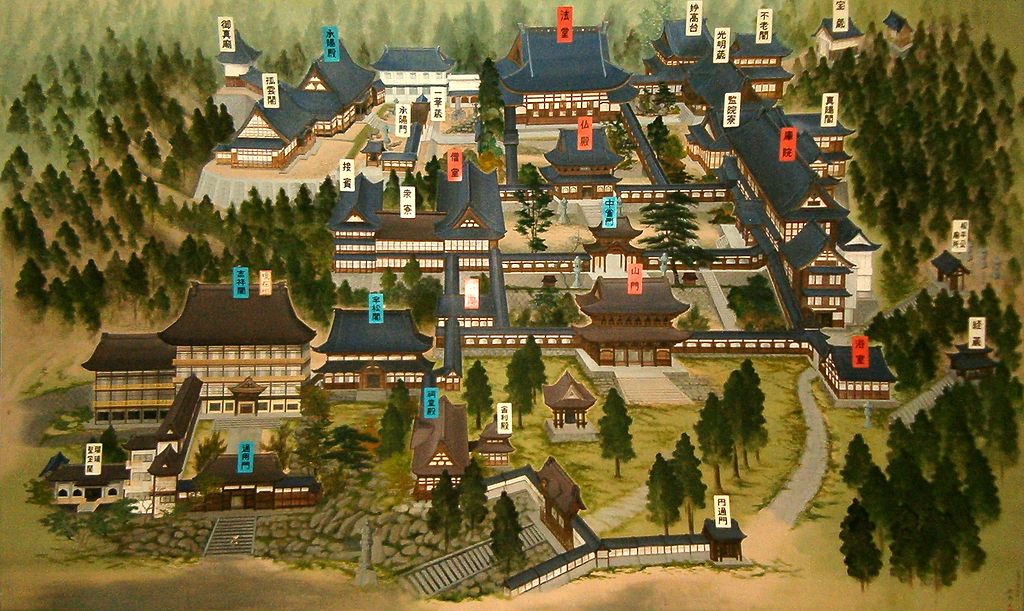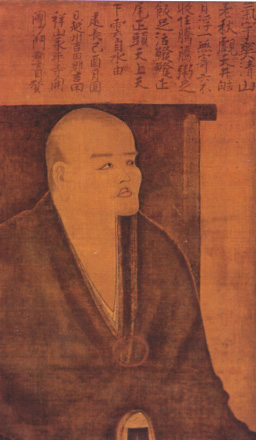
Dogen (1200-1253) is the co-founder with Keizan, of the Soto Zen School, one of the two main Zen schools in Japan. Dogen is now considered the greatest philosopher in ancient Japan, and his writings have become the focus of many scholars in the rapidly growing field of Dogen studies. This, however, has not always been the case. Before 1926, the year Watsuji Tetsuro published his Shamon Dogen, Dogen was virtually unknown outside the Soto Zen community. Hee-Jin Kim, whose Eihei Dogen Mystical Realist I will use for Dogen’s biography, writes: “Watsuji’s essay was a bombshell … For some seven hundred years prior to 1926, Dogen’s studies were pursued by sectarian scholars who approached his work with apologetic concerns and confessional hermeneutics … As a result, Dogen was venerated pietistically, but never studied critically.” In fact, until 1660, Dogen’s Shobogenzo had not even been taught in Soto Zen monasteries as the heads of these institutions focused on gaining members “among farmers, the common people, and powerful clans in the regions and provinces remote from the centres of the Zen establishment.”
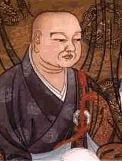
As for Keizan (1268-1325), who co-founded the Soto Zen school, his role was primarily institutional. Born fifteen years after Dogen’s death, he focused on the expansion of the school. Kim tells us that, to achieve this he reached out to ordinary people by adopting “certain aspects of esoteric Buddhism and folk tradition, such as a syncretistic mountain religion called shugendo.” Keisan founded several temples, among which Sojiji, which rivaled with Eiheiji as the main temple of the school. Having been brought up by a grand-mother and a mother who were both devoted disciples of Dogen, Keisan was especially keen to support the training of women. He is also known as the author of the Denkōroku (Transmission of the Light), a collection of dharma talks which many feel has been neglected, as today’s Soto Zen practitioners always refer to Dogen’s works. His success at popularising the Soto Zen school ensured its prosperity, but, as Kim notes, the Shobogenzo was “relegated to oblivion” in favour of the study of Chinese Zen Buddhism, and it is only in the seventeenth century that Dogen’s writings were revisited in the context of the “sectarian restoration movement.”
Early Period (1200-1212)
Dogen was born in 1200, a mere eight years after the beginning of the Kamakura period (1192 to 1333) which started when “Minamoto no Yoritomo was granted by imperial decree the hereditary title of shogun, the general in charge of governing the country.” Though the emperor remained on the throne, this event marked the beginning of an era of political rivalries that tore the country apart. This was a particular turbulent period in the history of Japan. In addition to the wreckage from human violence, the Japanese population had to endure epidemics, famines, fires, typhoons, earthquakes, tsunamis causing unprecedented levels of suffering. The new Kamakura schools – Pure Land, Zen, and Nichiren – arose as attempts to spread Buddhism among the general population, offering new, easier, practices to help ordinary Japanese cope with life in such exceptional circumstances.
Though this was also Dogen’s aim when he worked out the teachings and practices of the Soto Zen school, it could be said that the circumstances of his birth and education did little to prepare him for such an undertaking. He was born in Kyoto at the very heart of the Fujiwara family which had dominated the imperial court since the seventh century. Kim writes that he was “perhaps an illegitimate son of Koga Michichika and the daughter of Fujiwara Motofusa. He was among eleven sons and three daughters of Michichika … During the lifetime of Michichika, then the Lord Keeper of the Privy Seal, the family was at the height of its power and prosperity and controlled the pro-shogun force within the courtly circle in Kyoto. In addition, Michichika stood unparalleled in the literary circle … and was unfailingly devoted to the imperial family.” Dogen’s father died when he was only two, so “Dogen was raised by his mother and half-brother, Michitomo, in a culturally over-refined atmosphere. Many of his brothers and sisters occupied eminent positions in the imperial court and were well versed in poetry and the classics. It is not difficult to imagine that Dogen must have been systematically educated in the Chinese and Japanese classics, and well trained in literary skills and techniques that were the sine qua non of aristocratic life.”
Then, at the age of seven, “Dogen lost his mother, who at her death earnestly requested him to become a monastic to seek the truth of Buddhism and strive to relieve the tragic sufferings of humanity … We are told that in the midst of profound grief, Dogen experienced the impermanence of all things as he watched the ascending incense at his mother’s funeral service.”
This second personal tragedy led Dogen to develop a keen awareness of impermanence, and he later formulated his thought on enlightenment in terms of time and impermanence, rather than in the more usual terms of emptiness and form, concluding that “Impermanence is the Buddhahood.”
Kim continues: “Five years after his mother’s death, Dogen was confronted by another crisis. After he was orphaned, Dogen was adopted by Fujiwara Moroie, his mother’s younger brother, who at over forty years of age did not yet have an heir and consequently wanted to train Dogen for this honor. This meant the promise of a brilliant career for Dogen in the tradition of the Fujiwara hegemony … In the spring of 1212, Moroie planned to have a gempuku ceremony for Dogen to mark his initiation into aristocratic manhood. At this juncture, Dogen was forced to choose either to become a monastic or follow his uncle’s desire. Dogen decided to become a monastic, and visited Ryokan, another uncle on his mother’s side, in the Onjoji temple at the foot of Mt Hiei … Deeply moved by Dogen’s determination and motivation, Ryokan recommended that he study at the Senkobo on Mt Hiei, one of the most renowned centers of Buddhist studies at that time.
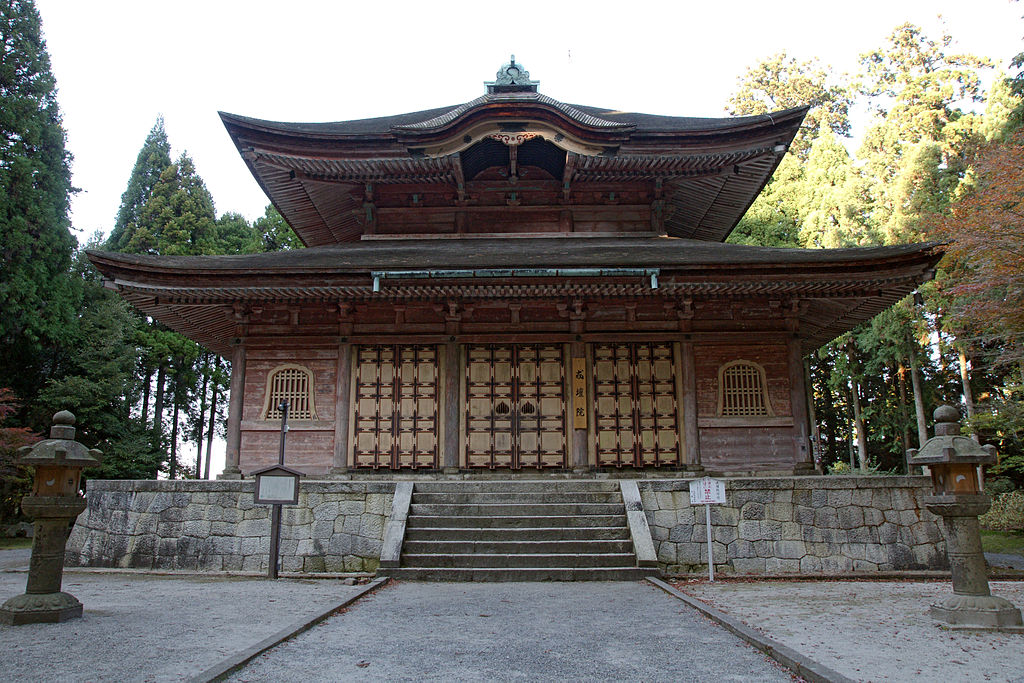
Monastic training at Mt Hiei and Kenninji (1213-1223)
Early in 1213, Dogen was ordained by Koen, abbot of the Tendai Enryakuji temple on Mt Hiei, and immediately embarked on a systematic study of Buddhist sutras at the Senkobo. Kim writes: “The impermanence of existence did not lead him to fatalism or to the pessimism that pervaded the age; on the contrary it led him to heightened vitality in the search for the Way.” In Dogen’s words: “The arising and decaying of all things occur swiftly; birth-and-death is gravely important … Having a transient life, you should not engage in anything other than the Way” (Shobogenzo Zuimonki)
Soon, however, Dogen was confronted with a question to which no master was able to give a satisfactory answer: “As I study both the exoteric and the esoteric schools of Buddhism, they maintain that human beings are endowed with Dharma nature by birth. If this is the case, why did the Buddhas of all ages – undoubtedly in possession of enlightenment – find it necessary to seek enlightenment and engage in spiritual practice?”
This was by no means a new question. It had been asked by the Tendai monastics involved in the elaboration of original enlightenment thought for over four centuries! But it is a question that came to the fore in Dogen’s writings as he took it as the starting point of his teachings. Only Rujing, with whom he studied and practiced at the Tiantong monastery in China would put Dogen’s mind to rest on this matter.
Kim tells us that, when Koen resigned as abbot, Dogen left Mt Hiei, with his question still unanswered. “He brought the question to Koin (1145-1216) at the Onjoji temple in Miidera. Koin was unable to answer” and he “instead, referred the young man to Eisai (1141-1215), who had returned from China to found Rinzai Zen and who resided at the Kenninji temple in Kyoto.”
Dogen is not indeed the man who brought Zen to Japan. Already in 1168, and again, for a longer stay in 1187, Eisai had gone to China, and been ordained in the Linji (Jap Rinzai) school, which was by far the most popular Zen school in Song dynasty China. On his return to Japan in 1191, Eisai had faced opposition from traditional Buddhist schools in Kyoto, and finally moved to Kamakura where he had built the Jufukuji temple. It is only in 1202 that Eisai had been able to found the Kenninji temple in Kyoto, where, as was the case on Mt Hiei, teachings from other schools were also taught.
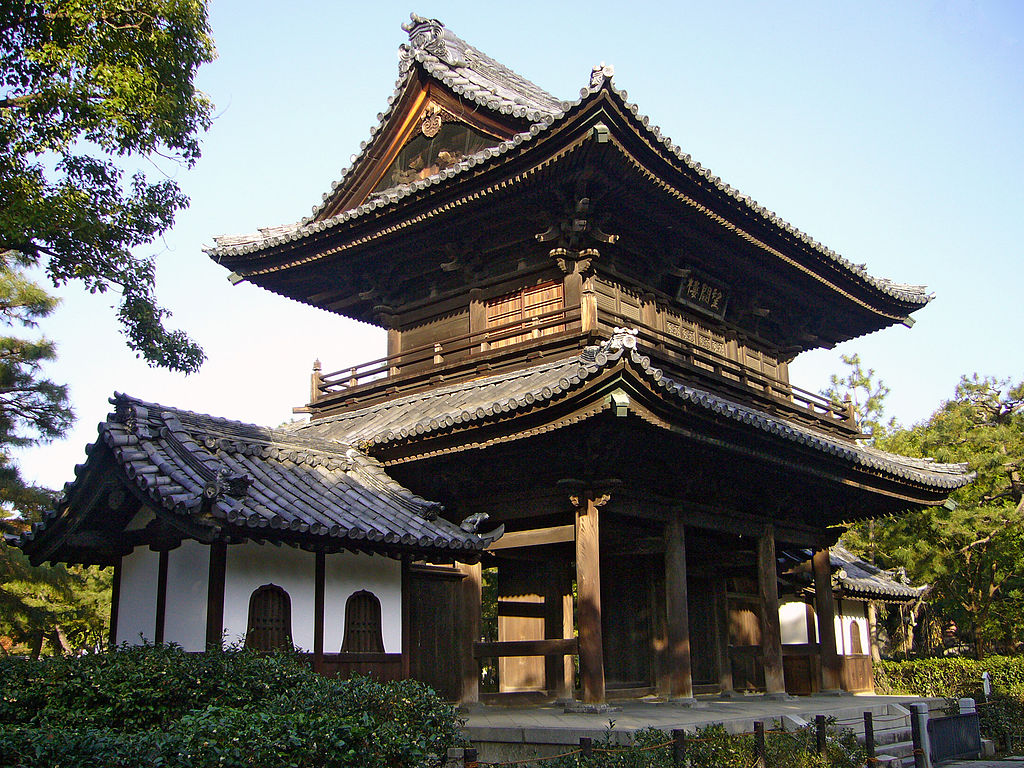
Kim explains that “Dogen apparently visited Eisai at the Kenninji temple in 1214. Founded by Eisai in 1202, the Kenninji temple was at the time not only the center of Zen, but was also the center of studies for Tendai, Shingon, and other schools of Buddhism. Indeed, Kenninji was a rival of Hiei and visiting Eisai under such circumstances was a bold venture for a young man of only fourteen … Despite the fact that there was an extremely short length of time between Dogen’s visit in 1214 and Eisai’s death in 1215 … Eisai’s lasting influence on Dogen cannot be denied.” I understand that some Dogen scholars have now thrown doubt over this alleged meeting between Dogen and Eisai.
When, after three years of wandering, Dogen finally settled at the Kenninji temple in 1217, Myozen had succeeded Eisai as the abbot, and it is under Myozen that Dogen studied Rinzai Zen systematically. The two men in fact developed a warm relationship. Still, Dogen’s question had not been answered, and his dissatisfaction now extended to the whole of Japanese Buddhism. Dogen writes: “Right teachers have not appeared in our country since olden times. How can we tell this? Observe their utterances … They did not attain the summit of an intellectual grasp of doctrines, much less the neighborhood of enlightenment. They merely transmitted words and letters, while their disciples recited names and sounds … Buddhism has not yet been disseminated in this tiny remote country, and right teachers have not yet appeared … When you don’t meet a right teacher, it is better not to study Buddhism at all.”
At this point, the idea of a trip to China, that had been suggested by Koin, arose in Dogen’s mind. Kim writes: “Dogen brought the matter to Myozen, and both began preparing to study abroad immediately after the Jokyu War. In the second month of 1223, after due formalities, a party of Myozen, Dogen, and others left the Kenninji temple and toward the end of the third month set sail for China from Hakata to Chikuzen.”
Study and Practice in China (1223-1227)
Kim tells us that, “while Myozen immediately entered the Ching-te-ssu temple on Mt T’ien-t’ung, Dogen lived on the ship, until early in the seventh month, when he was able to enroll at the Ching-te-ssu temple.” This short episode of Dogen’s life turned out to be memorable, because it is while staying on the ship that Dogen met the tenzo (chief cook) of a near-by monastery, a sixty-one year old monk, who had come on board to get Japanese shiitake. As it happened, Dogen learned a lot from the lively conversation he had with the monk on this occasion. The monk declined Dogen’s invitation to stay overnight, and insisted on returning to the monastery after buying the mushrooms. Couldn’t other cooks prepare the food that evening? Why did a monk his age have to cook anyway, instead of practicing zazen or reading the koans of old masters? The cook replied: “The reason for my being the chief cook at such an old age is that I regard this duty as the practice of the Way for the rest of my life. How can I leave my practice to other persons? … You, a good man from a foreign country, perhaps do not understand what the practice of the Way is, nor what words and letters are.” Upon hearing this old man’s remark, Dogen was “all of a sudden shocked and ashamed profoundly.” Dogen met the old cook on several occasions during his stay in China, and each time was an opportunity for learning.
In the seventh month of 1223, Dogen was able to enroll “at the Ching-te-ssu temple on Mt T’ien-t’ung where Wu-chi Liao-p’ai (d. 1224) was abbot. This was the same temple where Eisai had studied.” It was a leading centre of Zen Buddhism in China with over a thousand monastics.
Buddhism in the Song dynasty (1127-1279) was not nearly as strong and brilliant as it had been during its golden age in the Sui-Tang period (581-907). This was due to several factors, among them the moral degeneration of monastic communities, the rise of Neo-Confucianism, and the decline of Buddhism in India during the eleventh and twelfeth centuries which put an end to the cultural exchanges between India and China. Chan monasteries, however, had remained influential, and continued to attract thousands of monks. Still, Dogen was shocked by what he witnessed in the many temples he visited. He wrote: “Those who allegedly study vinaya in the great country of Sung (Song) drink heavily and are intoxicated.”
Kim continues: “Although he stayed a the Ching-te-ssu temple [on Mt T’ien-t’ung] for nearly two years under Wu-chi Liao-p’ai, Dogen’s spiritual needs were not fully satisfied … Upon Wu-ch’i’s death toward the end of 1224, Dogen left Mt T’ien-t’ung and began traveling extensively, visiting the various temples and monasteries of the “Five Mountains” and studying the characteristics of the Five Houses” of Chinese Zen Buddhism … but still did not find a right teacher.”
At that point Dogen decided with a heavy heart to return to Japan. Myozen, who had also been practicing on Mt Tiantong, died prematurely at the age of forty one. Just before his death, however, Dogen heard the news that Rujing (1163-1228), “well known as a peerless master” had been appointed abbot of the Mt Tiantong monastery.
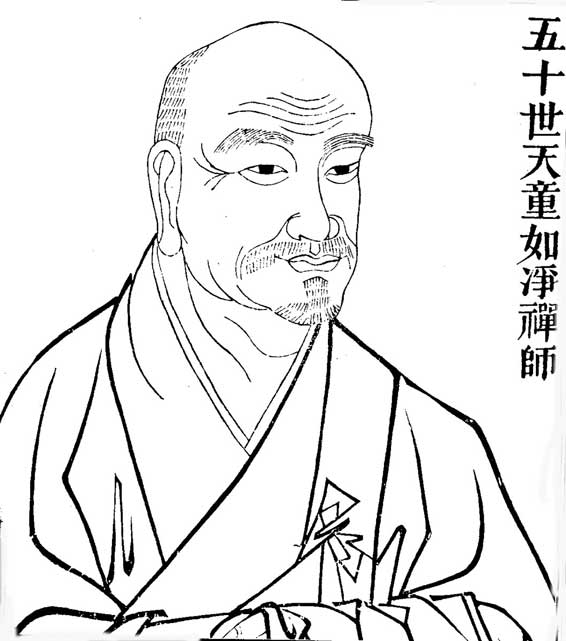
Dogen recounts his first meeting with Rujing in 1225: “I met Master Ju-ching (Rujing) face to face. This was an encounter between a man and a man.” Rujing told Dogen to visit him in his private quarters and freely asked questions. Dogen had met the “right teacher” he had been looking for.
Although the Tiantong monastery was traditionally presided over by abbots of the Linji (Rinzai) sect, Rujing belonged to the tradition of the Caodong (Soto) sect. Dogen had complete trust in Rujing, and he studied and practiced with him without sparing himself. He wrote: “I saw that Ju-ching (Rujing), accompanied by other elders in the monastics’ hall, used to practice zazen until eleven o’clock in the evening and begin at dawn as early as two-thirty or three; he never failed to practice this even a single night.” Rujing strongly opposed sectarianism and had no interest in worldly fame.
Kim then gives the traditional account of Dogen’s enlightenment experience which took place during the early morning session at a three-month meditational retreat: “In the course of meditation, a monk next to Dogen inadvertently had fallen asleep. Upon noticing the monk, Ju-ching thundered at him: “In zazen it is imperative to cast off the body and mind. How could you indulge in sleeping?” This remark shook Dogen’s whole being to its very core, and then an inexpressible, ecstatic joy engulfed his heart. In Ju-ching’s private quarters that same morning, Dogen offered incense and worshiped Buddha. This unusual action of Dogen prompted Ju-ching to ask: “What is the incense-burning for?” The disciple exuberantly answered: “My body and mind cast off!” “The body and mind are cast off!” joined the teacher, “cast off are the body and mind.” Thus, Ju-ching acknowledged the authenticity of Dogen’s enlightenment.” This was written by Kim in 1975. Shohaku Okumura says that two Japanese scholars now believe that Keizan, the second founder of the Soto school, invented the story. Dogen himself did not write about such an enlightenment experience, and, as it implies the concept of a practice leading to awakening, it contradicts Dogen’s teaching about practice itself being awakening.
Dogen himself writes: “The great matter of my entire life was thus resolved,” meaning that his question about the need for practice had been finally answered. While Dogen’s enlightenment experience may not have been as dramatic as the narrative implies, the story may still describe the key insight Dogen achieved while practicing with Rujing. Kim writes: “The significance of the key notion of “casting off the body-mind” in the context of Dogen’s life and thought was zazen-only symbolized the totality of the self and the world and represented that in which Buddha-nature became embodied. To cast off the body-mind did not nullify historical and social existence so much as to put it into action so that it could be the self-creative and self-expressive embodiment of Buddha-nature. In being “cast off,” however, concrete human existence was fashioned in the mode of radical freedom – purposeless, goalless, objectless, and meaningless. Buddha-nature was not to be enfolded in, but was to unfold through, human activities and expressions … The crux of his vision lay in a realistic affirmation and transformation of what was relative, finite, and temporal in a nondualistic vision of the self and the world. To understand duality lucidly and to penetrate it thoroughly within a nondualistic mode of existence was Dogen’s final solution. His remaining life consisted of his intellectual, moral, and cultic efforts to enact and elucidate this vision in the specific historical and social conditions of his time.”
Dogen returned to Japan in 1227 with “the sacerdotal role, the genealogical document of ancestral succession, his own portrait, and other precious objects. Except for these objects that he received from Ju-ching, Dogen returned to Japan ‘empty handed’,” in contrast to the many Buddhists who had brought back sutras, images and other documents. Rujing died a year later in 1228.
Creative Period Back in Japan (1227-1253)
Upon returning to Japan in 1227, Dogen went back to the Kenninji temple, after a four year absence. The situation there was still chaotic, but this did not prevent Dogen from getting down to the task of putting into words what he had learned from Rujing on Mt Tiantong. In the fall of that year, he wrote the Fukan Zazengi (Universal Recommendations for Zazen), which, Hee-Jin Kim says, “might have been regarded as the manifesto of Dogen’s “new” Buddhism vis-à-vis the established Buddhism of Japan.” The text is quite short, and focuses on the practice of shikantaza (“just sitting”). This particular form of zazen was taught in the Chinese Caodong lineage to which Rujing belonged, under the name of “Silent Illumination.” The very first lines of Fukan Zazengi emphasise that meditation as such, and of course, shikantaza in particular, was required, not as a practice leading to enlightenment, but as the “expression” of our already enlightened nature. Dogen writes: “Although [Sakyamuni] was wise at birth, the traces of his six years of upright sitting can still be seen. As for [Bodhidharma at] Shorinji, although he transmitted the mind-seal, his nine years of facing a wall is celebrated still. If even the ancient sages were like this, how can we today dispense with wholehearted practice?”
Dogen stayed at Kenninji for three years. Shikantaza had not been part of the Rinzai Zen practices taught at Kenninji where koan practice was central. Kim says that, as Dogen started to attract interest to his new practice, “enmity from both Hiei and Kenninji seems to have been aggravated.” This may be what drove Dogen to move to an abandoned temple in Fukakusa, another location in Kyoto, in 1230, where he embarked on the composition of his massive Shobogenzo (Treasury of the True Dharma Eye) with the chapter entitled Bendowa, “which expounded his basic tenets in the form of eighteen questions and answers.”
As the number of his students increased, Dogen moved again in 1233, this time to the Kannon-doriin temple, also in Fukakusa. Kim says that Dogen’s ten years (1233-1243) stay at this temple were his most creative period. He wrote forty-four chapters of the Shobogenzo, including the Genjokoan and Bussho, and expanded the original temple which he then called the Kosho-horinji temple, turning it into what Baizhang Huaihai (Po or Pai chang Huai-hai, 720–814) had envisioned as the proper layout of a Zen temple. His first move was the building of a monastics’ hall. Kim writes that “This was an epoch-making event in the history of Japanese Zen Buddhism, because it was the realization of Po-chang’s envisionment in which the monastics’ hall was the center of Zen monastic life.” This is where monks would practice zazen, take their meals and sleep. Both the centrality of the monastics’ hall in the layout of the temple grounds, and the lifestyle it entailed were adopted by later Zen monasteries. Po-chang is also known for his statement “A day without work is a day without food.” Zen monastics in China had engaged in manual labor, especially farming, to maintain their economic independence, and this had helped them survive the persecution of Buddhism in 845.
Dogen also built a Dharma Hall where lectures could be delivered. Kim writes: “It marked the realization of Dogen’s dream in which the monastics’ hall, the Dharma hall, and the Buddha hall became the three most important buildings of a monastic community. The Kosho-horinji temple was gradually shaping up as one of the most powerful centers of Buddhism in Japan.” The Kosho-horinji temple where Dogen lived no longer exists, but another temple, called Koshoji, was established in 1649 in nearby Uji as an homage to Dōgen’s original temple.
Kim says that “Dogen opened his monastic community for everyone, regardless of intelligence, social status, sex, or profession. His religion was through and through the religion of the people, as were other “new” Kamakura Buddhist sects.” Dogen also said that “monastics and laity are in essence one and the same.” Unlike Honen, Shinran, and Nichiren, however, Dogen did not try to adapt his teachings to the level of ordinary people living in the Degenerate Age. What he was really saying is that everyone was welcome to join his monastery. He was a firm believer in the necessity of a monastic routine in order to be able to actualise enlightenment. He stated: “Of all the Buddhas in the three periods and ten directions, not a single Buddha attained Buddhahood through the secular life.”
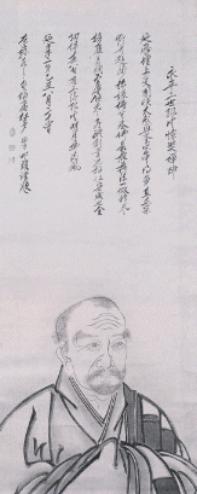
It was also at this time that Ejo became Dogen’s disciple, as well as head-monk of the temple. Ejo would later become the second patriarch of the Japanese Soto school.
In 1243, Dogen moved again, this time away from Kyoto, to the Echizen mountains. The reasons for this latest move are not known but Kim gives us a few guesses. Dogen was a purist, he had a burning sense of mission, and he was stubborn. Kim tells us that he had “relentlessly criticized the Buddhists of [Hokke, Kegon, and Shingon], calling them “the scholars who count words and letters.” Kim writes: “Coupled with his rising popularity, this stubbornness and sense of mission did not fail to irritate the traditionally-minded Buddhists, especially those on Mt Hiei. Dogen’s position at the Kosho-horinji temple became increasingly threatened by these traditionalists.” On the other hand, Dogen had not as yet heeded Rujing’s recommendation “Do not stay in the center of cities or towns. Do not be friendly with rulers and state ministers. Dwell in the deep mountains and valleys to realize the true nature of humanity.” And, of course, like Kukai before him, Dogen just loved mountains. He had even written a book expressing “his exaltation of mountains and waters.” So, when “Hatano Yoshishige, a well-known member of the supreme court of the shogunate in Rokuhara, who had become a follower of Dogen” offered him his own property in the province of Echizen for the site of a new monastery, it comes as no surprise that he accepted.
Dogen left the care of Koshoji to a disciple and moved to a small temple in a state of disrepair while Hatano supervised the building of a temple originally called Daibutsuji temple, which was officially opened in 1246 under the name of Eiheiji temple. “Eihei” means “eternal peace” and was the name of the era in the Later Han dynasty during which Buddhism was said to have been introduced to China.”
The Daibutsuji-Eiheiji period saw the writing of only eight chapters of the Shobogenzo, as Dogen “directed his efforts primarily to the formulation and guidance of moral precepts and disciplinary rules for the monastic community, rather than the exposition of his thought. This period was characterized by his concentration on the ritualization of every aspect of monastic life.”
From 1250 on, Dogen’s health started to decline. In the seventh month, on Hatano’s advice, Dogen traveled to Kyoto with Ejo and other disciples. Though he was treated at the home of a lay disciple in Kyoto, “his illness was too advanced to be cured by any medical treatment. In the eighth month of 1253, Dogen bade farewell to his grieving disciples and died in the posture of zazen.”
Source:
Hee-Jin Kim – Eihei Dogen Mystical Realist
